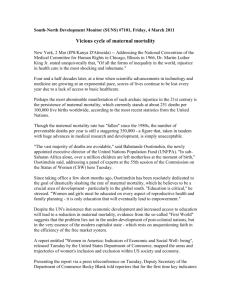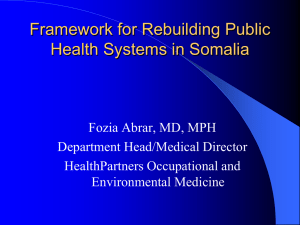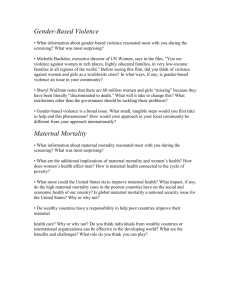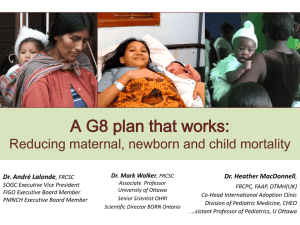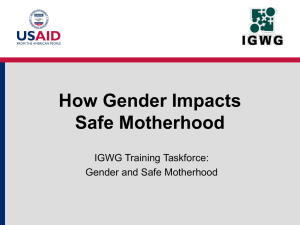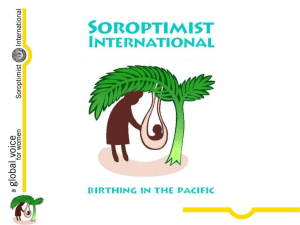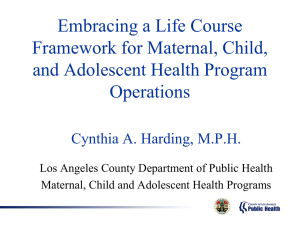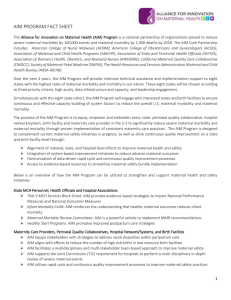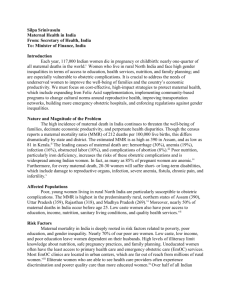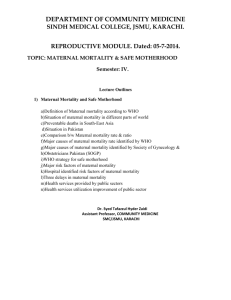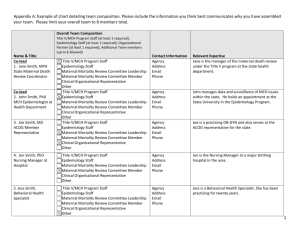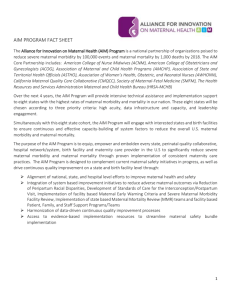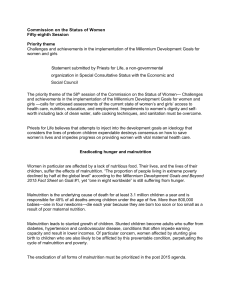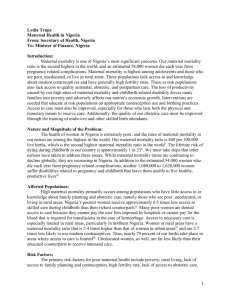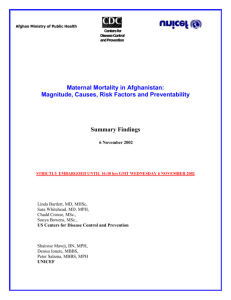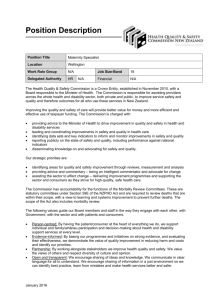NATIONAL ASSEMBLY
advertisement
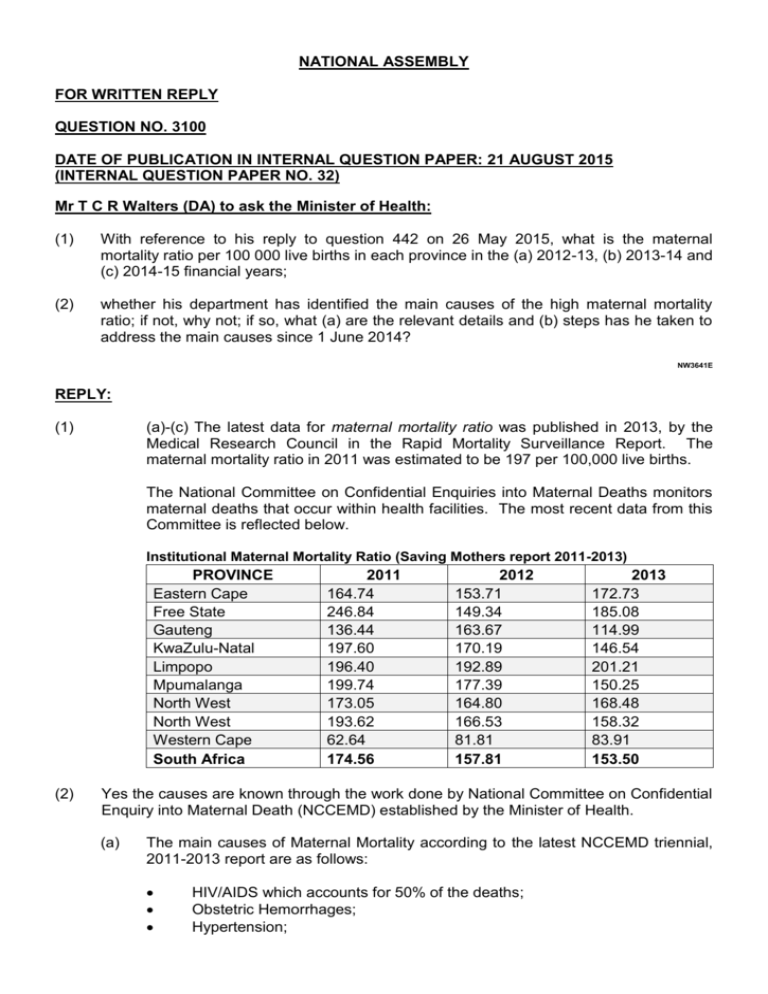
NATIONAL ASSEMBLY FOR WRITTEN REPLY QUESTION NO. 3100 DATE OF PUBLICATION IN INTERNAL QUESTION PAPER: 21 AUGUST 2015 (INTERNAL QUESTION PAPER NO. 32) Mr T C R Walters (DA) to ask the Minister of Health: (1) With reference to his reply to question 442 on 26 May 2015, what is the maternal mortality ratio per 100 000 live births in each province in the (a) 2012-13, (b) 2013-14 and (c) 2014-15 financial years; (2) whether his department has identified the main causes of the high maternal mortality ratio; if not, why not; if so, what (a) are the relevant details and (b) steps has he taken to address the main causes since 1 June 2014? NW3641E REPLY: (1) (a)-(c) The latest data for maternal mortality ratio was published in 2013, by the Medical Research Council in the Rapid Mortality Surveillance Report. The maternal mortality ratio in 2011 was estimated to be 197 per 100,000 live births. The National Committee on Confidential Enquiries into Maternal Deaths monitors maternal deaths that occur within health facilities. The most recent data from this Committee is reflected below. Institutional Maternal Mortality Ratio (Saving Mothers report 2011-2013) PROVINCE Eastern Cape Free State Gauteng KwaZulu-Natal Limpopo Mpumalanga North West North West Western Cape South Africa (2) 2011 164.74 246.84 136.44 197.60 196.40 199.74 173.05 193.62 62.64 174.56 2012 153.71 149.34 163.67 170.19 192.89 177.39 164.80 166.53 81.81 157.81 2013 172.73 185.08 114.99 146.54 201.21 150.25 168.48 158.32 83.91 153.50 Yes the causes are known through the work done by National Committee on Confidential Enquiry into Maternal Death (NCCEMD) established by the Minister of Health. (a) The main causes of Maternal Mortality according to the latest NCCEMD triennial, 2011-2013 report are as follows: HIV/AIDS which accounts for 50% of the deaths; Obstetric Hemorrhages; Hypertension; (b) Health professional training; Health system strengthening Interventions to address the main causes of maternal deaths being implemented include: (i) Option B plus to eliminate mother to child transmission of HIV This policy was adopted and implemented from 01 January 2015. The policy stipulates that all HIV pregnant and breastfeeding women must be initiated on lifelong antiretroviral treatment (ART) for the prevention of mother to child transmission of HIV and their own health regardless of CD4 count and on diagnosis. (ii) (iii) Essential Steps in the Management of Obstetric Emergencies (ESMOE) and Emergency Obstetric Simulation Training (EOST) ESMOE are trainings for doctors and midwives to improve their skills to manage, among others, hemorrhage and hypertension and are currently being done in all facilities rendering maternity care; EOST are fire drills to simulate the real obstetric emergency situations to refine and reinforce the clinical skills; To date, 1937 doctors and 5110 professional nurses have been trained on ESMOE. This has led to a 30% decline in maternal mortality due to improved health care providers’ skills in the management of mothers, neonates and children in the districts that we have conducted ESMOE training in; Community mobilization efforts (iv) Efforts of Health System Strengthening (v) (vi) Mom-Connect services which is an electronic cellular system to give health messages to pregnant women to help them access care early in pregnancy as well as post delivery. Currently over 508 000 women have been registered and receive weekly messages about their pregnancy and care for the infant post delivery; The District Specialist Teams (DCST’s) include specialists in maternal, newborn and child care, have been appointed in all 52 districts. This team is responsible for clinical governance within all public facilities and specifically focusing on Maternal Neonatal and Child Health; Efforts to address access to services Maternity waiting homes: Currently there are 81 maternity waiting homes + 18 on site beds nationally; Nationally there are 241 dedicated obstetric ambulances to improve access to health facilities; Family planning 2 The launching of the family planning campaign in 2014 and introduction of sub-dermal implant as a long term method of family planning had a positive impact on family planning practices. The Couple Year Protection Rate has improved from 37.7% in F/Y 2013/2014 to 52.7% in F/Y 2014/15. Improvement of family planning strategies assists in preventing unwanted pregnancies as well as teenage pregnancies which may lead to maternal mortality. END. 3



